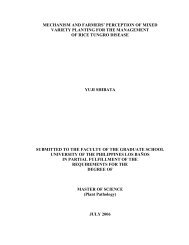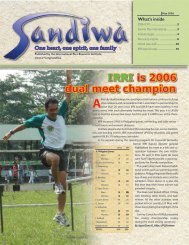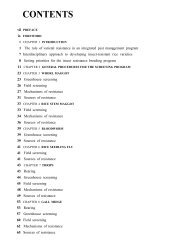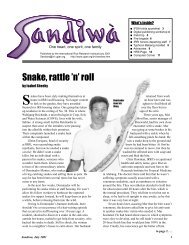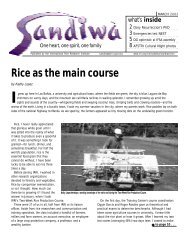Untitled - International Rice Research Institute
Untitled - International Rice Research Institute
Untitled - International Rice Research Institute
Create successful ePaper yourself
Turn your PDF publications into a flip-book with our unique Google optimized e-Paper software.
. Occurrence/distribution<br />
<strong>Rice</strong> blast is widely distributed in all rice-growing<br />
countries (Fig. 23). It is most prevalent in temperate<br />
subtropical environments and also in rice<br />
grown in upland conditions.<br />
c. Disease history<br />
Records of this disease can be traced back to as<br />
early as 1637 in China. It was reported in 1704 in<br />
Japan, in 1828 in Italy, and in 1907 in South Carolina,<br />
USA. In India, it was first recorded in 1913.<br />
Its causal fungus, Pyricularia oryzae, was named<br />
in 1891 in Italy. It was recently renamed P. grisea<br />
but P. oryzae has widespread usage.<br />
d. Importance in crop production<br />
Blast is generally considered as the principal disease<br />
of rice because of its wide distribution and<br />
destruction in causing crop failure and epidemics.<br />
The epidemic potential is very high under favorable<br />
conditions where susceptible cultivars are<br />
planted. Blast may cause total crop failure but,<br />
because resistant cultivars are grown widely in<br />
major rice production environments, it accounts<br />
for 1–3% yield loss across all rice production situations<br />
in Asia.<br />
Detection on seed<br />
a. Incubation period on blotter<br />
Using the blotter test, P. oryzae can be observed<br />
on rice seeds 3–4 d after incubation in NUV light<br />
at 21 °C. The detection frequency is about 9.9%<br />
on seeds coming from different regions (Fig.<br />
24a,b).<br />
b. Habit character<br />
Aerial mycelia are rarely present or in most cases<br />
absent. If present, mycelia are branched, hyaline<br />
to olivaceous. If aerial mycelium is absent, conidiophores<br />
arise directly from the seed surface singly<br />
or in small groups or bundles. They are moderately<br />
long, simple, and light brown. Conidia are<br />
hyaline, pale olive or grayish, and borne<br />
sympodially (Fig. 25a-c).<br />
c. Location on seed<br />
P. oryzae is observed mostly on sterile lemmas of<br />
the seed (91%) (Fig. 26).<br />
Microscopic characters<br />
a. Mycelium—septate, branched, and hyaline.<br />
b. Conidiophores—simple to rarely branched, moderately<br />
long, septated, light brown, slightly thickened<br />
at the base with denticles at the apex (Fig.<br />
25d).<br />
c. Conidia (sympodulosphores)—pyriform to<br />
obclavate, hyaline to pale olive; usually 2 septate,<br />
rarely 1 or 3 septate (observed in PJA); apex narrow,<br />
base rounded with a prominent appendage or<br />
hilum (Fig. 25e). Measurements: 15.64–22.54 µ ×<br />
7.82–10.81 µ (PDA); 16.56–31.97 µ × 8.51–12.42<br />
µ (PJA); and 15.18–25.76 µ × 7.13–10.81 µ(VJA).<br />
Fig. 23. Occurrence of blast (Ou 1985, CMI 1981).<br />
28



